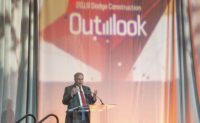Overall construction growth, already slowing down over the last few years, won’t pick up any steam in 2019 as housing shortfalls negate gains in non-buildings sectors, according to economic forecasts analyzed by ENR.
Following mostly increasing numbers over the last several years, construction starts will see basically no change next year, says Dodge Data & Analytics in its 2019 Construction Outlook. Dodge reports that construction starts will reach $806.8 billion in 2018, a 3% increase from the 2017 figure of $785.3 billion. But starts for 2019 are expected to rise only 0.2%, to $808.3 billion.
“During the 2012-15 period, total construction showed an annual growth in the 11% to 14% range, which was then followed by some deceleration in 2016 and 2017 as total construction starts advanced 7% each year,” says Robert A. Murray, senior vice president and chief economist at Dodge Data & Analytics. “This deceleration was expected, since expansions typically register slower growth as they mature.”
Material prices also are expected to remain at a higher rate through 2019, says Murray. While the U.S. Bureau of Labor Statistics’ producer price index reported restrained increases in the years following the economic downturn in 2008, prices rose 3.6% in 2017. For the first nine months of 2018, prices are up 6.5% overall, with most of the increases coming from metal materials, as aluminum mill shapes, copper wire and steel mill products each posted double-digit increases. Some of the rising material costs can be attributed to the 25% steel tariffs and 10% aluminum tariffs that were imposed by the Trump Administration on Canada, Mexico and the European Union this past June.
An FMI Corp. market forecast predicts next year’s total construction put-in-place to increase 5.6% to $1.4 trillion, roughly the same as this year’s escalation of 5.5%. Its outlook also calls for an increase of 6.2% in non-residential construction, up from last year’s 5.3% rise.
FMI expects housing to grow 5.9%, slowing down from the 6.7% rate last year. FMI principal Jay Bowman remains optimistic about next year’s market performance. “Certain markets may not be as positive looking, but we still think 2019 will be a good year,” he says.
|
Related Link |
Housing To Slide
Total residential starts are expected to experience a 6% boost by the end of 2018, according to Dodge. The strengthening economy has renewed demand for single-family homes, which increased 6%, while multifamily housing rose 5%. However, Dodge expects housing to post a 2% downturn in 2019, with multifamily housing dropping 6% and single family construction staying flat.
“So far this year, economic conditions have remained largely beneficial to single-family housing,” says Murray. “But conditions are changing.” He notes that the housing construction sector is showing signs of maturity, and points to the negative impact of last year’s tax cuts on the market.
“By increasing the standard deduction and limiting other deductions, the new law reduces the tax advantages of home ownership,” says Murray.
Still, the National Association of Home Builders predicts single-family housing starts will continue to rise, reaching 927,000 starts in 2019, a 4.7% increase from 885,000 in 2018. NAHB expects that increase to continue into 2020, with starts reaching 979,000. Starts in multifamily housing will rise 7.6% in 2018, 383,000 from 356,000, but will see a downturn in the next two years. NAHB is forecasting a drop of 4.4% in 2019, followed by a 0.5% decrease in 2020.
The Portland Cement Association offers a more optimistic outlook for 2019. It reports a 1.4% increase in construction put-in-place in 2018, up slightly from 1% growth the previous year. In 2019, PCA expects the rise to hit 2.2%.
Both residential and non-residential construction are forecasted to improve in 2019, with non-residential coming back from a 0.9% decrease in 2018. Also looking more positive next year is the industrial construction sector, set to increase 4.9% after falling 6.6% in 2018.
“The economy is strong,” says Ed Sullivan, PCA senior vice president and chief economist. “While there may be factors that are beginning to emerge that could lead to a softer pace of economic and construction activity, it will probably take some time for economic growth to unwind.”
Transportation Boosts Public Works
PCA forecasts a 2.4% boost in public works in 2019, followed by smaller bumps of 1.2% and 0.2% in 2020 and 2021, respectively. “Public construction activity represents a significant adjustment to PCA’s overall construction outlook,” notes Sullivan. “In previous forecasts [when] the construction sector weaken[ed] under the weight of higher interest rates,” he says, a Trump administration infrastructure plan was expected “like a great white knight, to prop up weakened private construction spending.” While speculation grows that it could finally come in 2019, “based on discussions with our Washington, D.C., office, this help may not materialize until later in the forecast horizon, and the levels of stimulus may be smaller,” Sullivan explains.
Looking toward the future, “PCA assumes a more modest infrastructure spending initiative supplementing existing programs” will start in 2022 and “gradually build up spending strength over the course of three years,” says Sullivan. “This means the crux of the impact of the supplemental infrastructure spending will materialize in the years beyond the forecast horizon.”
The American Road & Transportation Builders
Association (ARTBA) reports a 4.6% increase in highway work in 2018, to be followed by a 4.9% increase in 2019. After a 2.2% drop this year, bridge work is expected to increase 1.6% in 2019.
“The federal transportation programs will receive a boost from supplemental general funds,” says Alison Black, ARTBA senior vice president and chief economist, citing the $2.5 billion approved by Congress in fiscal 2018 as part of the Fixing America’s Surface Transportation (FAST) Act. An additional $930 million has been approved for 2019. Still, she says that the outlook “could be tempered by any potential delays in the reauthorization of the federal-aid highway program and finding a fix for the Highway Trust Fund.
Although the FAST Act provides funding through next year, it is difficult for states to plan projects amid the uncertainty.”
“The economy is strong. While there may be factors that are beginning to emerge that could lead to a softer pace of economic and construction activity, it will probably take some time for economic growth to unwind.”
– Ed Sullivan, Senior Vice President and Chief Economist, Portland Cement Association
She adds that before the act passed, “21 states had expressed concerns about the feasibility of future transportation projects and some states even delayed or canceled projects.”
According to Dodge’s outlook, highway and bridge construction will increase 3% in 2019, following a 7% jump in 2018. Environmental public works will rise 6%, due in part to the passing of the America’s Water Infrastructure Act in October. The bill includes $3.7 billion in federal funding for flood control and other water infrastructure.
“Wastewater treatment … was one of those declining markets for a while and now it’s picking back up,” says Bowman. “When you look at the capacity of a lot of wastewater treatment plants, you’re getting the level where you’re required to expand.” FMI’s construction put-in-place for water supply infrastructure is expected to rise 7.1% in 2018 and 5.7% in 2019. PCA forecasts an even larger increase this year for water supply construction put-in-place, at 10.1%, but pulls back to a 3.7% increase in 2019.
Electric power plants saw a 25% drop this year. Murray attributes this to the start of only two natural gas-fired power plants valued above $750 million in 2018—the $1.3-billion South Field Energy power plant in Ohio and Entergy’s $872-million Lake Charles power station in Louisiana. Dodge predicts that starts will drop an additional 3% in 2019.
Dodge reports that construction starts in the commercial building sector will close out 2018 at a 2% increase, largely spurred by the 10% gain in hotels and motels and the 18% jump in manufacturing structures. In 2019, overall commercial starts will drop 3%, with a 6% decline in the hotel sector generating the largest loss.
“Two factors, casino proliferation and convention center growth, have played important roles in hotel expansion, but both could now be faltering,” says Murray. As the legalization of gambling has increased over the past several years, casino growth has been “a boon to hotel construction,” says Murray. But the boom is slowing with gambling already legal in 37 of 50 states. A convention center uptick provided a boost in 2017 and 2018, with large projects such as the $1.2-billion Javits Convention Center getting underway, but slower growth will dampen starts in the coming year.
Institutional building is expected to rise 3% in 2019, following a 1% increase in 2018, says Dodge’s forecast. Murray partly attributes this to an uptick in education construction linked to a predicted 6.9% increase in university enrollment in the next five years, which will require continued expansion. K-12 school enrollment is also expected to increase in the same timeframe, at a rate of 1.1%





Post a comment to this article
Report Abusive Comment